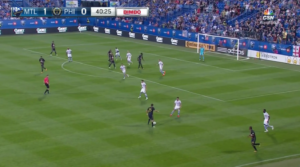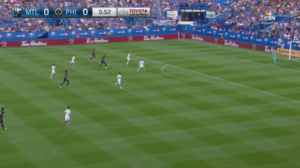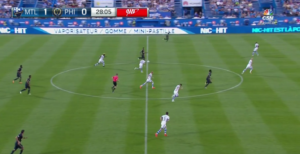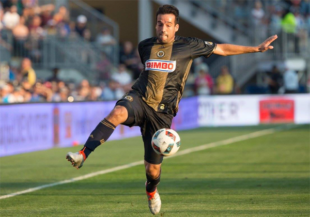Montreal Impact wanted to high press. Philadelphia Union wanted to high press. Both teams wanted to transition with speed. But once they entered the final third, nobody was quite sure what to do.
Even with their full squad available, the Union have often pushed forward with speed this season, choosing to play more of a field position game than develop play in midfield. To the extent that they do retain the ball, they often aim to create space for Haris Medunjanin in the defensive half. Medunjanin — and, to be fair, Jack Elliott — have shown they can identify and target spaces both within and around a defensive shape. This allows the Union to move the ball forward effectively without retaining the services of a playmaker that operates close to goal.
The downside, of course, is that the Union have rarely looked coherent around the goal, both on the break and when retaining the ball.
Although these issues tend to be highlighted by Ilsinho’s poor decision-making, the truth is that the Brazilian has been very effective moving the ball forward through the center. Philly has not, however, found anybody who can both attack a soft center and create shooting opportunities close to goal. This is likely what has set off the almost incessant and not unreasonable calls for recruiting an attacking midfielder that can control play around the box. Remember: As good as Haris Medunjanin has been at addressing problems moving the ball out of defense, Earnie Stewart wanted a controlling midfielder. Even with the big Bosnian, the Union do not look like a team capable of controlling many games. When they start to do that — by acquiring an attacking midfielder, bringing the fullbacks higher in attack, moving the centerbacks forward when the ball is in the attacking half, or any other approach — Philly will finally look able to control the flow of a match for an extended period of time.

Ilsinho on the ball with Union attackers lining up for a cross
Decision-making and planning
The promise of Ilsinho, of Marcus Epps, of Fafa Picault is in their 1v1 abilities. Let’s not restrict this to battles with the ball, because Picault has emerged as a supremely difficult matchup off the ball. His central runs and smart strafes into space are essential when the Union draw teams to the right then look to switch play.
But as all three players demonstrated last night, the Union need to become more coordinated in how they move off the ball when they do establish their wing players in dangerous positions. For example, in the 41st minute sumptuous play from Picault on the left led to a Union attack up the right, with Ilsinho moving forward and Gaddis smartly overlapping quickly. This led to a situation in which the Union had four players in the box and Ilsinho on the ball facing forward. Sounds good, right?
It got better. The quick transition left the Impact defense disjointed, with the left side five yards higher than the rest of the back line. However, nobody moved into the gaping hole in the box. Instead, everyone lined up for a cross. From Ilsinho.
The Brazilian eventually cut inside and played an ambiguous pass toward either C.J. Sapong or Roland Alberg in a crowded central area and the moment was lost.
Assigning blame on this individual play is less important than grappling with why the player on the ball and the players capable of receiving it in a dangerous position were at odds as to their best course of action. Should Ilsinho be looking to cross the ball? Or should the attackers be trying to move into the empty spaces the Brazilian creates by drawing defenders to toward him? Notably, the answers to these questions are likely to change if the words ‘Chris Pontius’ replace ‘Ilsinho.’ Yet Philly’s response to the situation did not.

Sapong pushes the defense deep and chooses a pass over a shot.
Attacking awareness
Another huge question highlighted by Wednesday night’s loss is whether C.J. Sapong can make one final leap and marry his defensive unselfishness with a bit more attacking egotism. Sapong was once again the key man in Philly’s defensive structure, and Montreal worked extremely hard to move him away from Laurent Ciman during buildups. Yet when he receives the ball in good attacking positions, the Union striker’s selflessness remains to a fault.
In the 6th minute, Philly created a turnover in Montreal’s half and Sapong strode forward with Medunjanin in support to his left. After backing the defense into their own box, and with space to shoot, Sapong elected to slip the ball wide to Medunjanin.
Jay Simpson has received criticism for being a bit too selfish on the break, but the knock on Sapong is the opposite. ‘Strikers need to score’ is not an anachronistic mantra, but goals are a smaller part of the striker’s role than they have ever been in soccer. Sapong can take this to the extreme, however, and fail to recognize shooting opportunities when they arise. This is what currently separates him from similarly hardworking MLS strikers like Dom Dwyer, and it is one of the few things that can be cited as a reasonable defense of keeping the Union man off the initial Gold Cup squad.

Sapong rolls into space but does not recognize he can burst behind the defense.
Drilling down, though, Sapong’s recognition of shooting chances hints at an attacking awareness that tends to wane in transition. In the 29th minute, Roland Alberg found himself advancing quickly in space through the left channel. The left side of Montreal’s defense was caught high following a turnover and Sapong had intelligently rolled off of Ciman toward the huge gap behind Kyle Fisher. Alberg spotted the run and played a ball into space.
But Sapong wasn’t making a forward run, he was just finding space while he waited to react to Alberg. The ball rolled past the striker harmlessly.
Particularly in a match where Sapong’s endless work was essential to limiting Montreal’s ability to play through Ciman, it is important to note where the striker can continue to improve. Without a reliable playmaker in transition, Sapong will need to recognize when chances to break in behind arise, and then he has to take them.
Counterpressing can be counterproductive
Under Jim Curtin, the Union have become progressively better at pressing the ball. From the undisciplined early days of Seba Le Toux chasing anything vaguely resembling a round object, the team now has recognizable pressing cues and has shown the ability to execute a team-wide press for 45 minutes at a time.
What the Union rarely do, though, is attempt constant pressure on the ball. They have, of course, tried. In a 3-3 draw with Montreal earlier this season, Philly produced a strong, high, and consistent press for the first half before overextending themselves and falling apart up their right.
In his second game of the year, Warren Creavalle was tentative in his attacking movements and quick in his defensive actions (as per usual). Trouble arose when Creavalle gave in to the desire to immediately make up for mistakes and press out of position.
[gfycat data_id=FluffyFreeHummingbird data_autoplay=false data_controls=false data_title=true]
In the 33rd minute, Creavalle plays a poor, 20 yard pass into the Montreal back line. The ball is kicked back out and quickly moved to the Montreal left. Creavalle presses the first man in midfield then follows the ball to the left. Theoretically, this could be a positive. If Creavalle adds extra pressure before the Impact can organize, the Union can force a turnover or at least a long pass they can corral.
In order for Creavalle to leave the center and counterpress, the Union as a whole need to be thinking counterpress. The players around the ball do, but the rest of the team fails to collapse toward the ball, picking up the secondary options can quickly undo pressure. The essence of this issue is the importance of transition moments, and the Union have consistently struggled to maintain focus during these key times in a match. Recognizing pressing cues and responding appropriately is far easier when the opposition is moving the ball around the back, and it is much more difficult in the wild and crazy seconds following a turnover. Mastering those moments will make Philly a far harder team to break down in transition.
Impact goals
Finally, the two Impact goals. The functional beauty of the buildup to the opener cannot be ignored. The home side was bound and determined to play through Laurent Ciman, and this meant pushing the center back as far as possible from CJ Sapong and patiently holding the ball deep until a chance to rotate to the left arose. Watch as the Impact bring players into the center until they pull Sapong off of Ciman. At this point, the Union defense enters a period of uncertainty, with Medunjanin assuming Sapong will rotate to Hernan Bernardello and Fafa Picault caught between stepping up or following Chris Duvall. Meanwhile, Michael Salazar has moved Giliano Wijnaldum inside to produce space behind Picault and it’s a simple task for Bernardello to pick out the fullback once he has time to look up.
[gfycat data_id=ReasonableDownrightAsiaticmouflon data_autoplay=false data_controls=false data_title=true]
What should have happened?
Notably, Medunjanin was far more aggressive following players that dropped deep following the goal, indicating that Philly was willing to challenge Montreal to create when they did not have a numerical advantage in the first line. This pressure forced the Impact to play more negative passes, one of which led to Fafa Picault’s FIFA 98 goal.
There is less to say about the second Montreal tally. The goal itself may appear lucky and a function of poor defense, but the real culprit lies further afield. The Impact possession began deep in the Union half when Ilsinho attempted to beat a man on the right and lost the ball. In these transition situations, chaos often ensues. Montreal quickly moved the ball to their most dangerous attacker, and he had the joy of operating in a 1v1 with Jack Elliott both in support and eyeing Montreal’s striker to his right. That striker was onside because Ray Gaddis remained deeper than his teammates and had yet to recover his line following the turnover. So even if Matteo Mancosu had touched the ball, Philly would have been in trouble.


I am so so so sorry you have to break down that disaster of a game..
Thanks for the support. It wasn’t the prettiest, was it.
This is a great explanation for the continued WOES of this team and Im not gonna lie, I appreciate very much the author highlights very early on in the read that which was so infuriating to me in the 59th min abtotal lack of movement off the ball….. el Poacher would approve.
.
Zizou and now Adam managed to pull me back in this week…as it’s too redundant to even discuss anymore. Well done.
.
Should be interesting to see how the U handle Columbus. They can leave lots of space in the middle spreading their attack out.
Fortunately the Sixers, Flyers and Eagles are getting set to begin play. That may help dull the pain of the Union and the Phillies.
Sorry, nope. Except for the occasional phils game, Finding it hard to watch not-soccer, even when it hurts. Union til I die, but last night’s game is moving me closer to that distant light
I have been season ticket holder since the beginning.
But if they continue with this alchemy experiment and don’t actually sign at least one more DP during this window, I am going to seriously consider not renewing.
I understand that (properly managed) the Academy and BSFC are the future of the Union and will eventually make the franchise great, but if they want me to pay now, they should do what it takes to have a legitimate product now.
Is Jay Sugarman investing his money into this program? Seems like he is not. You should not either. At this point the best thing that could happen is the collapse of the season ticket holder stream and MLS forcing him to cash out.
Adam, I’m always impressed with your long form strategic and tactical gap analyses. Far more astute than any “color analyst’s” so-called “keys to the game.”
.
Which makes me wonder, based on each analysis and recent performance history, could you provide a succinct “keys to the game” as part of pre-game previews. Or is that already being covered by posts I’ve missed?
So, I do the occasional preview here. The hard part of doing a pre-game “keys to the game” is that unlike the Union, basically every other MLS team does things like “rotate personnel” and “make formation tweaks” and “make functional in-game adjustments”. It makes it hard to do this kind of breakdown pre-game. The Union seem to be by far the most static team in the league.
All the more reason to do it Adam. It might sound repetitive but given frequency, maybe the message will sink in. Sugarman, at least, reads PSP, right?
“Static” is generous. Union are mired in predictable and repeatedly unsuccessful tactics. They need a coach who can get the best out of these players. And who can coach offense, defense, and can develop young players. Rosenberry and Marquez have regressed under Curtin. Ilsinho and Albert’s value is way less than the Union are paying them. Pontius is struggling. CJ is burned out. Again. I’d rather Sugarman pay $ for a real coach than he make a big DP signing right now. If you gave Curtin a DP striker – say Cuba Torres for example – he would misuse him as a hold up striker or wide midfielder (like he does with CJ every time Simpson comes on up top) in his simplistic dedication to a 4-2-3-1. We have a coach who can only coach one freakin’ formation!
Sorry, but no, it doesn’t look like JC can coach a 4231 either
So ok, they are going to stick to the 4-2-3-1. How about trying Fafa up top instead of CJ. He’s played there for other clubs right? He makes runs that no one else can. Curtin just doesn’t get creative enough in the borders this club has set itself.